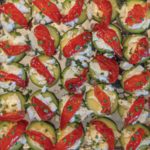Guest blogger today is our good friend David Kamerer, of Spoonful. His Spoonful isn’t normally about edibles, however I think it should be on occasion because David is one helluva cook. On numerous occasions, we’ve had the delightful experience of eating David’s pizzas. My husband asked him to teach us how to make the dough, and David not only enthusiastically accepted our invite, he typed up the blog post below. So, cheers to you David for sharing your talents and being my first guest blogger!
Dear Princess Adriene,
Pizza has made me friends, gotten me out of culinary jams and brought my family together in the kitchen. It’s one of my favorite things to make. You can top a pizza with just about anything, so I won’t get into that now. But here is the recipe for the crust:
The only ingredient you’ll need that you may not have is yeast. Buy a jar of dry yeast – those little packets are very expensive! This recipe presumes that you have a sturdy mixer, such as a KitchenAid.
Prep time: about 15 minutes. Rise time: 45 minutes or more recommended.
Ingredients needed: water, sugar, flour, yeast, salt, olive oil, corn meal.
Makes two 12” round pizzas.
Start with a cup of warm water. I put cold water in the microwave for 20 seconds. Pour it into your bowl, and swish it around to warm the bowl and take the heat out of the water. Mix in a teaspoon of sugar. Pitch a teaspoon (or a packet) of yeast into the mix and let it wake up for 30 seconds to a minute.
Add a cup or more of flour, and continue adding by half cups as you run your mixer on low with the dough hook attached. You’ll need more than 3 cups, possibly up to 4, but this varies.
As your mixture becomes the texture of warm pudding, add a teaspoon of salt and up to four tablespoons of olive oil. This is also a good time to mix in any herbs or other personal touches that you might like to bake into the crust. Continue adding flour until it becomes dough. As it gets stiffer, add flour in smaller qualities. Your goal is for the mixture to clean first the sides and then the bottom of the bowl.
The more you mix, the better the dough will bake. As you mix, the flour creates gluten, and becomes resilient and stretchy – the better to hold in the carbon dioxide bubbles released by the yeast.
When the dough cleans both the sides and bottom of the bowl and you’ve mixed for at least five minutes, you can shape the dough into a ball and put it in a bowl to rise. Put a tablespoon of olive oil in the bowl first, drop the dough in, then invert it so the entire surface is oiled. Then cover the bowl with a tea towel and let it rise until doubled in size, about 45 minutes. It will rise more quickly in a warm place.
When dough has risen, place on a floured work surface and divide in two (you’re making two crusts). Roll into the shape and size desired. Place some corn meal onto a baking peel (or cookie sheet) and transfer dough to it. Top it and you’re ready to bake it.
I recommend as high a temperature as your oven will go, or 450 degrees F. If you have a stone, place it in the oven before you preheat, and use the baker’s peel to transfer it, making sure to use plenty of corn meal so your pizza slides easily into the oven. It will bake for 10 – 15 minutes, so just watch it. You’ll know when it’s ready to pull out.
A’s Side note: this pizza is David’s creation – blue and feta cheeses, pear and almond (he uses walnuts, but I only had almonds on hand). It’s a delightful pizza!
Important note: this is a very flexible recipe. The only way you can fail is if you kill the yeast with too hot water. The sugar is optional. The olive oil in the dough is optional. It does taste better with salt. The key thing is to work in the right amount of flour, and let the mixer do its job so you get a good rise.
Variations: Chicago style deep dish – substitute up to one cup of cornmeal for flour. When you divide the pizza, remember that you’ll need to reserve about one-third of each half for the top of the crust. Use round 8” baking pans for stuffed pizza, and try to keep the filling on the dry side. Poke a few holes in the surface to let moisture escape.
New York style: omit oil and roll it out thinner.
Whole wheat: I would start with about a cup of white flour, and then work in whole wheat from there.
Calzone: make four crusts from one recipe. Roll each into circles. Fill half with ingredients, close and pinch crust edges. Poke a few holes in the surface to release moisture. Brush with olive oil and parmesan and bake.
You can make bigger pizzas by starting with more water, say up to 1 1/3 cups.
I rarely make conventional pizzas with tomato sauce. If you’re doing something more adventurous, it’s often a good idea to brush the dough surface with olive oil before topping. It will bake up to a glorious golden brown when you do.
I frequently bake one crust and freeze the other. Just cover it with plastic wrap and place in the freezer. I find that if I begin thawing at lunchtime, it’s ready in time for dinner. Cover it with a tea towel and let it thaw in an oiled bowl, and spray some Pam or otherwise oil the surface to keep it from drying out.
To make foccacia, just roll it out thicker than usual, dimple the surface with your fingers, brush with olive oil and your favorite toppings, and bake.




